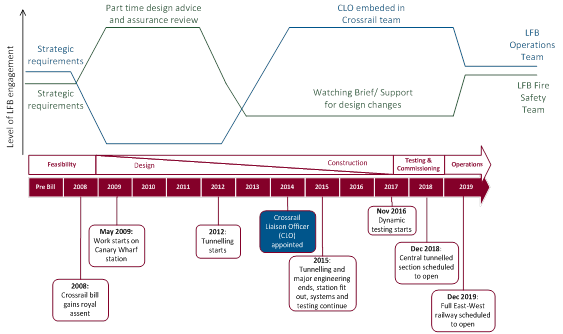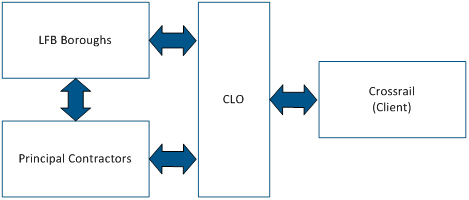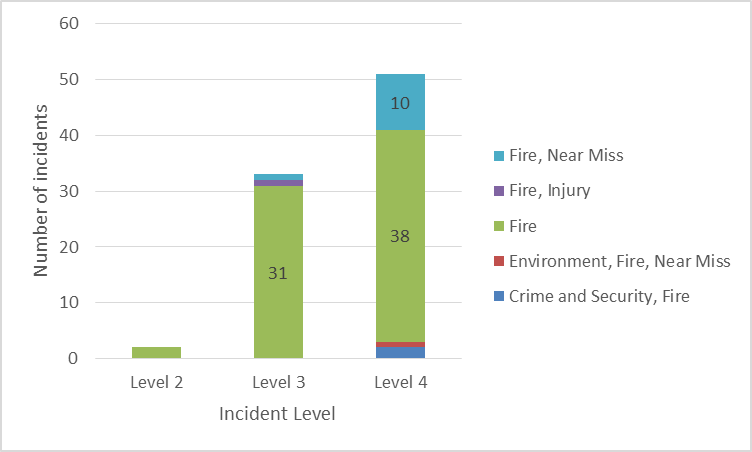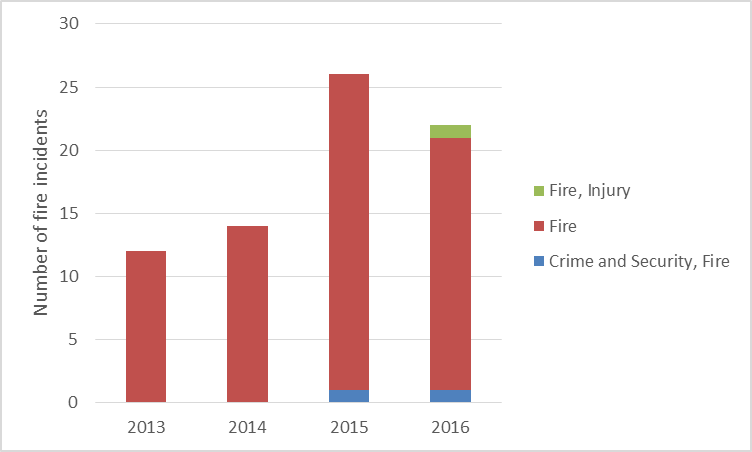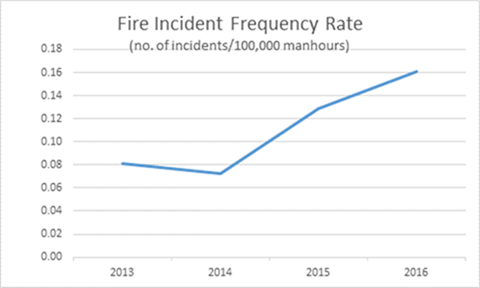
Crossrail LFB Emergency Services Liaison
Document
type: Case Study
Author:
Dave Bulbrook, Stephen-Remell Coleman, Darren Selman Dip2OSH, CMIOSH, MCQI CQP, MIIRSM, AIEMA
Publication
Date: 24/10/2017
-
Abstract
The London Fire Brigade have officers seconded to Crossrail to support activities ensuring that sites are as fire-safe as possible. This paper discusses lessons learned from the London Fire Brigade on collaborative working with Crossrail and recommendations for future major projects as well as sharing the various requirements and other key documents used on the programme.
By having a London Fire Brigade (LFB) liaison officer embedded within the Crossrail project, there has been a risk reduction to the LFB and Crossrail. This has been achieved through the development and implementation of fire assurance assessments, operational response planning, exercise planning and safety event investigations. This serves as a good practice model for reducing fire safety risk on major projects that cross boroughs and/or have multiple construction sites.
This paper will be of interest to fire safety managers and health and safety managers responsible for fire safety on major projects.
-
Read the full document
1. Introduction
Over the last 20 years London Fire Brigade (LFB) has played a key role in supporting a number of major projects including Channel Tunnel Rail Link (CTRL), Heathrow Terminal 5 (T5), Wembley, London 2012 Games and Dockland Light Railway Woolwich Extension.
LFB have been involved right from the start of the Crossrail project, from the late 90s during the consultation, then during the hybrid Bill preparation in the early 2000s, the design phase and up to the present day during the construction phase. The early stages involved strategic level meetings looking at the design, fire and rescue service operational procedures and facilities that would inform the design of the running tunnels and stations in operations and, building on the learning from the CTRL, for the provision of fire services during the construction phase. The fire safety input in the design stage was very much led by the CRL fire safety team with assistance from LFB, but this paper focuses on the role of the LFB, specifically the CLO role and how it was implemented within the project. Therefore the focus is mainly on the construction phase of the programme.
During the construction phase, projects such as Wembley and T5 located on a single site are managed by the LFB at a local level with some specialist central support. Complexity is added when projects cross boroughs or are on multiple sites, such as on CTRL and Crossrail, and therefore ensuring coordination by fire response teams is vital.
CTRL was the first project that LFB assigned a single project liaison officer to provide this coordination of response across multiple boroughs. This was an unfunded resource and LFB undertook site visits and sample checks with issues presented to the contractors for resolution. This was initially the approach taken by Crossrail, supported by quarterly blue light meetings, and an LFB resource to support the design team through design reviews. However, as construction picked up, fire was assessed as a more significant hazard in the safe delivery of the works and concerns were raised by the insurers of the project. Hence Crossrail approached LFB in 2014 to enquire about an increase in resources dedicated to the Crossrail project. The provision of this service was seen as mitigation by the insurance companies.
It was agreed that a funded LFB officer – the Crossrail Liaison Officer (CLO), would be embedded within the Crossrail Health and Safety team who would be responsible for identification of hazard and mitigation of risk.
This paper discusses the role of the CLO on the project and its suitability as a model for future major projects.2. Timeline
Figure 1 – Engagement by LFB’s Operations and Fire Safety Teams
The CLO, delivery and operational railway advice was provided by LFB’s Operations Team whilst design support was from LFB’s Fire Safety Team. Figure 1 above shows how the level of engagement of the two LFB teams changed during the life of the programme.
During the Feasibility and Planning stages both teams contributed to the design process and modelling. Following this stage LFB’s Operation Team engagement ramped down during the design phase and then began to ramp up again at the start of construction and vice versa for the Fire Safety Team which ramped up during the design phase and provided a reduced watching brief during the construction phase.
At the start of the construction phase the LFB Operations team supported seminars for newly appointed contractors to help them understand the approach that the emergency services take in London when responding to emergencies. This was facilitated by Crossrail’s Delivery Director and helped inform emergency arrangements for each of the contractors. The CLO role started in 2014 during the construction stage.3. Governance Framework
A memorandum of understanding was drafted which set out the terms of engagement.
The LFB engagement was to:
-
Provide advice to Crossrail, its staff, contractors and service providers on the delivery of multi-agency operational planning, facilities and response arrangements for the management of fire safety and risk at all venues throughout the construction, commissioning and hand-over phases of the project. This involved unannounced visits to Crossrail construction sites;
-
Provide fire safety advice in relation to the design and construction of stations and infrastructure in relation to operational planning , emergency plans and response;
-
Provide access to specialist Fire and Rescue Service experts within, or available to the LFB;
-
Liaise with Crossrail, the LFB and other Fire and Rescue Services and other related agencies on the Fire and Rescue Service matters in connection with the project.
-
Provide recommendations in any project related area that may affect fire safety of Crossrail workers, contractors, other members of the public or emergency responders.
The framework was implemented in 2014 with the intention of running for the life of the project until the railway goes live and Rail For London’s operational fire management team take over.
The Crossrail Liaison Officer (CLO) is based in Crossrail’s head office at Canary Wharf, within the Health and Safety Department (Assurance team) and has two reporting lines:- Fire and Rescue Service line management at LFB Operational Resilience
- Head of Health and Safety Assurance for all fire safety- related matters
4. Crossrail Liaison Officer (CLO) Activities
The CLO is responsible for providing the following support to Crossrail:
- Advice and recommendations for incident prevention
- Advice and recommendations for incident response and operational planning
- Advice and recommendations for the management of fire safety and risk at construction sites – Including Specialist support from operational officers and transport fire safety engineers to resolve technical issues
- Advice to Crossrail on LFB capabilities and expectations for operational response during construction and commissioning
Figure 2 – The CLO is the interface between the Boroughs, the Contractors and the Client
4.1 Incident Prevention
4.1.1 Reducing Risk of Fire Through Assurance Assessment
The Crossrail Liaison Officer (CLO) is responsible for reducing risk from fire to Crossrail employees and emergency responders to as low a level as reasonably practicable through the identification of hazards. The significant reduction in risk is achieved by conducting fire assurance assessments across the London section of the Crossrail line, covering the tunnel’s service shafts and associated 9 new stations. These assessments are both pre-planned and upon request, such as following incidents, through investigations from incident reporting or from a development perspective.
However undertaking audits in a client organisation was not something that LFB had done before and hence the CLO had to work with Crossrail to develop a suitable process. Additionally, Crossrail has clearly defined audit procedures in place which only allows qualified auditors to undertake audits. Hence a process of fire assurance assessments was developed including a template for assessment based on the LFB incident management requirements . When issues were identified through the assessment process, recommendations on improvements were made in the assessment report for implementation by Crossrail or contractors.
An escalation route for reporting issues was established through the monthly H&S managers meeting or through the Safety, Health and Environment Leadership Team (SHELT) meetings.4.1.2 Reducing Risk Through Trend Analysis
Rivo is the online database tool used by Crossrail to record incidents and investigations, key performance indicators, inspections and audits, and corrective actions.
The classification of fire incidents in the RIVO System are on a scale of 1-5 where 1 is the most serious down to 5 being a minor incident. The defintions of the classifications are shown in Table 1 below:
Table 1 – RIVO Fire Classification Levels
A key part of the CLO role is to monitor all the recorded RIVOs for fire-related issues and areas of concern. Figure 3 below shows the 86 fire related incidents occurred over a period of three years and 4 months.
Figure 3 – Fire related incidents and near misses between May 2013 and September 2016
Considering the size and complexity of the Crossrail programme, the number of incident logged is relatively small. In addition, more than half of the incidents were classified as level 4 which is one of the least severe of the fire levels. Only 1 fire related injury was received and this was a minor burn from a catering fire.
Looking at the fire related incidents over time (figure 4 below) there have been 74 fire incidents, (excluding near misses), between the period May 2013 to September 2016.
Figure 4 – Fire related incidents over time.
When compared to the 6.8 million hours worked in that period, that is an Incident Frequency Rate of 0.11 (no. of incidents/100,000 hours worked). It would be interesting to compare these figures against other major projects but unfortunately the data is not available.
Looking at the incident frequency rate over time in Figure 5 below, a rising incident frequency rate trend is seen which coincides with the transition from excavation to fit out phase. The Project has seen an increase in smoking on site, however, the increase is most likely the result of improved training of staff for ‘fire all outs’ which has meant that smaller previously unreported fire incidents are now reported as “standard practice.”
Figure 5 – Fire Incident Frequency Rate over time
The CLO investigates and attends sites to review and (where necessary) add assurance to existing contractor protocols. Where patterns begin to form, that are not necessarily restricted to individual sites, Crossrail is informed. The CLO’s subsequent actions can range from contacting the health and safety director and affected contractors to a system-wide health and safety notification.
Through continuous monitoring and challenging of site behaviours and processes, Crossrail has altered the way in which fire related incidents are reported. For example, the CLO identified that small fires were being safely extinguished on site, but underlying causes and trends were not being identified. This analysis resulted in Crossrail’s senior leadership and contractors participating in a workshop to identify the potential risks to Crossrail and the wider construction industry from not investigating these fires. Consequently Crossrail undertook to call LFB fire investigators to ‘fire all out’ incidents. This attracted a smaller non-emergency attendance which reduced disruption to the project and provided essential learning on the causes of fire and fire spread. This was publicised through system-wide communication and presentations.
4.2 Incident Response – coordinating response to a fire incident
The CLO is also responsible for coordinating the response to a fire incident by the LFB including liaison with other emergency services. The CLO can gather relevant operational information to be used in LFB planning, which can be shared with other emergency services. This information informs LFB operational resilience and response arrangements for any emergency situation, including the facilities and equipment available to responders during construction. This role also underpins the LFB’s Operational Resilience responsibilities through partnership working to reduce the impact of emergencies in London.
4.3 Incident Operational Planning – advice and guidance to construction sites
The CLO was also able to coordinate specialist support to assist in operational planning for fire safety of complex engineering challenges.
Managing Fire Risk During Extraction of the TBMs at Farringdon Station
The last of Crossrail’s eight tunnel Boring Machines (TBM) ended its run at the site of the new Farringdon station and plans had to be put into place to safely remove the now redundant TBMs. Whilst the majority of the TBMs could be extracted through the new tunnels or overheads shafts, the location of the work and its close proximity to existing infrastructure meant that the cutter head was too large for either option.
It was decided that the safest way to remove the cutter head was to cut it into manageable pieces which could be safely extracted to be sent for recycling. The most efficient way to carry out this cutting was with the use of oxyacetylene cutters, although from the outset it was understood by all that carrying out this activity underground presented substantial fire risks if not managed correctly. Crossrail, the Principal Contractors for the site, and the LFB worked closely to identify all hazards and put in place an effective mitigation plan. Controls included keeping the oxygen and acetylene gas tanks on separate floors of the structure and piping direct to the torch, the construction of fire shuttering across tunnel mouths, water curtains (with associated upgraded drainage) and a strict point by point safe system of work. In addition, the Metropolitan Police, City of London Police, British Transport Police, London Ambulance Service and Local Authorities were involved in planning for the activity to ensure that all stake holders were fully aware of the activity and how risks were being managed.
Throughout the entire planning process the LFB were centrally involved, providing information and guidance on the management of the gases and the controls that needed to be implemented to ensure that the work was carried out with as little risk as possible. Only when all parties were in agreement that the works plan was safe was work permitted to commence. Cutting up of the cutter head took place over the space of two weeks and as a direct result of the planning that went into the activity, there were no incidents or injuries associated with the work.4.4 Monitoring and Site Inspections
Monitoring the provision and availability of firefighting facilities and equipment and resolving related issues is the most operationally important part of the CLO’s role. Each contractor has a fire engineer and health and safety manager who report on their respective arrangements to support Fire and Rescue Service response.
The CLO facilitates meetings and surgery days with the contractors’ fire engineers to establish a uniform standard of emergency response arrangements and facilities, and ensures they reflect the changing hazards of the project.
This monitoring includes ensuring continuity of fire fighting water and fire and rescue service communication systems, ensuring that access routes are available and reception arrangements are appropriate. Where any shortfall is identified this is immediately raised with the Crossrail Assurance Manager and directors are notified to encourage swift resolution. Monthly updates are provided to the Crossrail Senior Health and Safety Executive Leadership Team (SHELT), where any issues and good working practices can be identified at directorate level. Non compliant contractors in the most extreme cases have resulted in stopped works until satisfactory mitigation is put in place. Normal cases have resulted in contractually-binding corrective actions put in place following the CLO’s observations. In one case the LFB’s Fire Safety team assisted to provide support to correct actions by contractors.4.5 Development of the Role
4.5.1 Liaison Role
The CLO role involves active participation in a number of groups, committees and working parties within Crossrail on behalf of the LFB, focussing on the agreed Emergency Services’ operational response protocols and LFB requirements, during construction and for the finished project.
These include Fire Engineering meetings when designing the finished mass transit railway & system-wide management groups dealing with the construction phase.
Activity includes a review of relevant recent and historic incidents (beyond this project) and the use of audit and assurance information to identify trends. This information also feeds into meetings, audit comparisons and joint visits with Crossrail’s insurers to help inform their exposure and determine if further mitigation is required to reduce their risk.
The impact of progress and proposed changes on the blue light services and other partners are mitigated through the involvement of LFB fire engineers in meetings and a wider partnership approach.4.5.2 Events
The CLO has also been involved in a number of awareness- raising and resilience testing events, including:
- ES power 1000 – coordinating the fire contingent of a high-profile media event being held in the Crossrail Canary wharf station
- Gold response exercises – supporting the development of exercises to test Crossrail’s strategic response arrangements
- Stepping Up Week – CLO supported the Crossrail behavioural safety culture through engagement with Stepping Up Week (a week focused on raising safety awareness across the programme) that included sessions on fire safety specific to each construction site.
5. Resilience Partnership
Working alongside the embedded Metropolitan Police Service officer at Crossrail offices the LFB led the establishment of a multi-agency resilience planning group. This has been key to Crossrail adopting partnership planning practices to support resilience partnership principles from construction through to the commissioned system. This work has included the support of London Resilience. Other key resilience stakeholder meetings included LESLP and JESIP.
This resilience partnership provides the forum to support Crossrail’s commitment to test and demonstrate that the project will suitably mitigate civil emergencies throughout the remainder of the construction stage to commissioning and beyond. This has included table top and live exercises during the construction phase and will also support the planning for commissioning exercises. This group is now chaired by the British Transport Police.
Regular reports are provided to LFB director and senior managers on any issues raised.6. Lessons learned and recommendations for future major projects
- A key lesson learned is that it would have been beneficial to appoint the CLO earlier, for two reasons:
a. To cover the whole construction phase, i.e., when facilities are starting to be provided for firefighters (for example, some duplication of work could have been avoided if the permanent and temporary fire mains had been coordinated earlier in the programme) and when complexity of fire response expands beyond a standard project. The temporary construction stage is when infrastructure is most vulnerable, as systems are more secure once the railway is operational.
b. During earlier consultation stages to ensure knowledge retention, as information on early discussions was lost due to personnel changes throughout the life of the project. A CLO throughout would provide consistency. - The CLO was seen by the supply chain as supportive and as part of the Crossrail team so it was not a ‘them and us’ approach. Future projects should ensure that a CLO has the softer skills required; to be sociable but still have sufficient authority.
- Part of the CLO role was to provide internal updates within LFB when significant changes took place on the project, e.g., changes in the construction of the railway, and how to deal with changes, in line with LFB procedures. A lesson learned is that LFB might benefit from greater engagement between the CLO and borough commanders through seminars, exercise planning and monthly briefings that should be scheduled at the start of the project.
- It is recommended that future contracts include a requirement for contractors to have not more than 20m of tunnelling unprotected by a fire main during the construction phase and that the fire main is handed over as an asset from one contractor to another. This recommendation has come about due to an issue that arose on the Western tunnel contract. These construction works had excellent fire safety with a fire main ring every 20m that continued through to Farringdon so a water mist curtain could be created to segment off all fires. However, the contractors were contracted to strip this system out at the end of their contract which meant that it then had to be reinstalled by the follow-on contractors.
- Firefighting provisions were vague in the Works Information and resulted in the need for a temporary fire main and communications had to be installed before the permanent fire main and communications, leading to additional cost. It is recommended that works information includes a requirement to consider early installation of permanent fire fighting provision including water and communications so that it can provide protection during the construction works and negate the need for a separate temporary fire main to be installed.
- Many agreements were made in relation to fire during the consultation phase which were recorded in minutes but were then hard to locate in subsequent phases. For example, agreements regarding C5 and water were lost. It is recommended that future projects create a joint emergency services commitments/agreements register that carries on through each phase of the project with hyperlinks to relevant minutes. One of the CLOs first jobs should be to collate all agreements.
7. Conclusion
Embedding a CLO into the Crossrail H&S team has facilitated a mutually-beneficial arrangement.
It has provided the LFB with access to specialists from a range of professional disciplines who have informed the LFB’s management of the latest practice in the private sector.
The visibility of the CLO through training, briefings, site walks, assessments and safety alerts, combined with a collaborative approach to problem solving, has helped ensure high standards of fire safety on site and a positive fire prevention attitude.
Crossrail’s senior managers have been quick to respond to assurance assessment outcomes. Actions have included inviting contractors to stand down until the risks associated with identified hazards are removed or reduced to a reasonable level. No contractors had to be instructed to do so.
The learning from this partnership has been used by Crossrail and the LFB to produce fire safety guidance bulletins for contractors, and publications free of charge for the wider construction sector to inform fire safety standards around the world.
By having a London Fire Brigade (LFB) liaison officer embedded within the Crossrail project, there has been a risk reduction to the LFB and Crossrail. This has been achieved through the development and implementation of fire assurance assessments, operational response planning, exercise planning and safety event investigations. LFB helped to solve problems rather than just raise issues.
This serves as a good practice model for reducing fire safety risk on major projects that cross boroughs and/or have multiple construction sites.
Additionally the CLO role is a service that could be sold by LFB to international clients.
-
-
Authors
Darren Selman Dip2OSH, CMIOSH, MCQI CQP, MIIRSM, AIEMA - Crossrail Ltd
Darren Selman was Head of Health and Safety Assurance on Crossrail from 2012 until September 2016. He is a Chartered Safety and Health Practitioner who has held a number of Health and Safety roles in the rail industry over the past 20 years in organisations including Eurostar, London Underground and Bombardier. Darren built up a substantial railway knowledge during his career and has covered fleet maintenance, operations, stations and facilities, as well as railway and civil construction. He joined the Crossrail team in 2012 where he implemented a new regime of contractor Health and Safety assurance activities, including audit and assessment. He was also responsible for the management of other assurance processes covering CDM management, fire safety and Business Continuity.
-
Acknowledgements
Norman Perry, LFB Station Manager, Information Support
Steve Foye, Area Manager Hampshire Fire and Rescue Service, Support to assist independent review of paper
-
Peer Reviewers
Les Fielding FIFireE, MCIHT, MIFSM, London Bridge Associates Ltd, ATC
Steve Ash, Group Manager Hampshire Fire and Rescue Service
